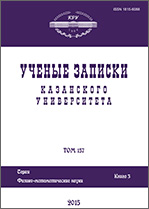|
This article is cited in 1 scientific paper (total in 1 paper)
Effect of the liquid temperature on strong compression of a cavitation bubble
A. A. Aganin, T. F. Khalitova
Institute of Mechanics and Engineering, FRC
Kazan Scientific Center, Russian Academy of Sciences, Kazan,
420111 Russia
Abstract:
The influence of the liquid temperature in the range of 273.15–419 K on the vapor compression inside a collapsing cavitation bubble in acetone has been studied. The liquid pressure is 50 bar. The vapor in the bubble is initially in its saturated state, the bubble radius is 500 $\mu$m. The fluid flows are governed by the gas dynamic equations with wide-range equations of state, taking into account the heat conductivity and evaporation/condensation on the bubble surface. The numerical technique is based on a TVD-modification of the Godunov method of the second order of accuracy in space and time. Five vapor compression scenarios have been found to sequentially implement with decreasing the liquid temperature. The first scenario is close to homogeneous, the other ones are with the convergence of: one isentropic wave, one shock wave, one isentropic and one shock waves, and two shock waves. At that, the vapor temperature maximum achieved at the boundary of a small central region of the bubble (with a radius less than 2.5 $\mu$m) until the first shock wave focusing grows nonmonotonic.
Keywords:
acoustic cavitation, bubble collapse, convergent shock waves.
Received: 18.03.2018
Citation:
A. A. Aganin, T. F. Khalitova, “Effect of the liquid temperature on strong compression of a cavitation bubble”, Uchenye Zapiski Kazanskogo Universiteta. Seriya Fiziko-Matematicheskie Nauki, 161, no. 1, Kazan University, Kazan, 2019, 53–65
Linking options:
https://www.mathnet.ru/eng/uzku1501 https://www.mathnet.ru/eng/uzku/v161/i1/p53
|

| Statistics & downloads: |
| Abstract page: | 237 | | Full-text PDF : | 138 | | References: | 18 |
|




 Contact us:
Contact us: Terms of Use
Terms of Use
 Registration to the website
Registration to the website Logotypes
Logotypes








 Citation in format
Citation in format 
